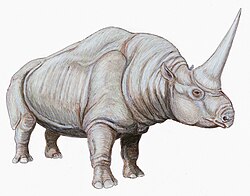You can help expand this article with text translated from the corresponding article in German. (March 2024)Click [show] for important translation instructions.
|
| Diplacodon | |
|---|---|
 | |
| Head reconstruction of Diplacodon | |
| Scientific classification | |
| Kingdom: | Animalia |
| Phylum: | Chordata |
| Class: | Mammalia |
| Order: | Perissodactyla |
| Family: | † Brontotheriidae |
| Genus: | † Diplacodon Marsh, 1875 |
| Species | |
| |
Diplacodon (Greek: "double" (diplos), "point" (aki), "teeth" (odontes) [1] ) is a genus of prehistoric odd-toed ungulates in the family Brontotheriidae. One species, D. progressum, was later placed in the novel genus Pseudodiplacodon . [2]









